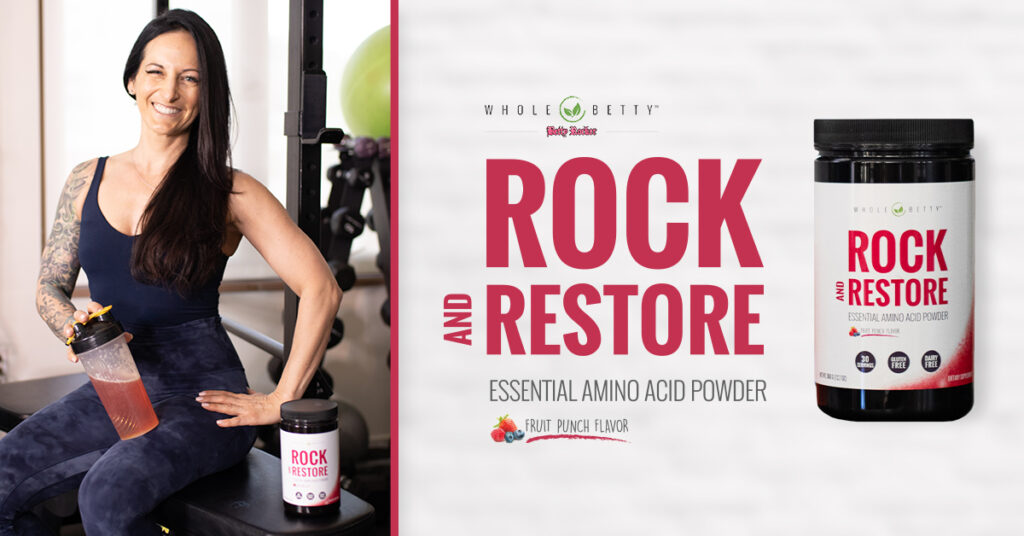I just got this question in Rock Your Life, and I thought it was a great opportunity to create a reference for you! Shoutout to the Rock Your Life members who always ask such great questions!

First, a quick note on PROTEIN itself…
The protein you eat gets broken down into amino acids, but different foods provide different combinations of amino acids and not every food contains all the essential amino acids. Of the 20 some amino acids, there are 9 that the body cannot make on its own and must get from dietary sources. These 9 are called the “essential amino acids.”
Without adequate consumption of all of the essential amino acids, the body may break down healthy tissue like muscle tissue to obtain the amino acids needed to perform essential functions like making energy, enzymes, neurotransmitters, hormones and its immune response role. And you don’t want your muscle breaking down just because you’re not eating properly.
Maintaining your muscle as you age is an essential piece in remaining strong, mobile and healthy.
While your workouts certainly support the production of muscle, unless you are fueling them appropriately they simply will not respond and your body composition may trend in the direction of more fat, less muscle rather than more muscle, less fat. If you’re curious about how muscle works (and how to take care of it), I put together a comprehensive article I consider essential reading for all active women right here.
Unlike fat and carbohydrates, which the body can store easily for later use in the liver and fat cells, the body doesn’t store amino acids for later use – which is why it’s important to include protein regularly throughout the day in your meals.
1. Protein powders
My organic protein powders (like Vanilla Protein and Berry Green Protein) make great shakes and smoothies and you can bake with them. One of the things I recommend avoiding in your protein powders is added sugars. Mine use organic stevia or organic monk fruit to naturally sweeten the powder without adding sugar to your body.
They are excellent sources of dietary protein (your body treats them just like food where it breaks it down to amino acids) and can boost your overall daily intake of essential amino acids – and in the case of the Berry Green Protein, broaden the spectrum of greens you’re accessing as well.
Because we don’t absorb amino acids as readily as we age, it’s ideal to increase your overall daily intake once you’re over 40.
The recommendation for active women under 40 is approximately 20-30 grams of protein per meal. If you’re over 40, it’s recommended to increase your serving to 30-40 grams per meal, consistent with what I’ve been told by doctors who work in the exercise field. Listen to this episode with Dr. Gabrielle Lyon if you’re interested in more on these recommendations.
I also encourage you to listen to the 2-part podcast series with Dr. Stacy Sims in which we discuss training with your cycle, post-menopause, and women specific nutrition and training tips. You’ll hear us talk a lot about protein and the importance of it, all framed within a conversation about your health and life cycle.
While getting 30 grams of protein in a meal may feel daunting at first, I recommend looking at your overall intake for the day and seeing how you might boost that with the addition of a quality supplement like mine.
For instance, making a smoothie or a shake with a serving (or even a serving and a half to two servings) of your protein powder can boost your overall intake of amino acids for the day.
Simple recipes like protein pancakes or protein waffles are also a great way to get some extra protein in – just boost the ingredients by adding a serving of protein powder. It can be challenging to get enough protein in without a little help and this is really something to pay attention to, especially if you’re active.
A note on baking with protein powder: Keep in mind that protein powders, like flour substitutes, cannot be just swapped into a recipe without some testing and care. The base of what a protein powder is made from will affect your recipe. One thing you’ll notice in my meal plans and recipes here on the blog is that if protein powder is called for I’ve used my own but I’ve given you the equivalent amount in GRAMS, so you can measure your own protein powder the same way.
While I always recommend using my protein powder in my recipes, that’s not always possible and I want you to have options to test. A “serving” of one protein powder may be a different amount than another brand’s serving, because the ingredients may not all be as concentrated or they may have other ingredients as well (such as greens, or other foods). That’s why I recommend you start with the gram equivalent, and then experiment from there. I cannot guarantee that my recipes, tested with my own brand, will work with every other protein powder out there, even if you do match the grams but this is a good starting point.
If you’re not using my protein powders (which are organic and plant-based), please read this guide I created to help you in choosing a good protein powder for yourself.
2. Collagen peptides
Collagen contains quite a few amino acids, but 3 particularly in abundance and they specifically support bone, skin, and joint health. Collagen is NOT a “protein” in the sense that it doesn’t have all the essential amino acids your body can’t make on its own, and you can’t count it towards your daily protein intake.
However it is an excellent supplement, and the reason I take it is for its support to my joints, skin and bone health. I do consider it a BONUS supplement, so if you’re on a budget, prioritize a high quality protein powder, like my Berry Green Protein or I ❤️ Vanilla protein powder.
Collagen used to make its way into our diets through foods like bone broths, slow-cooked organ meats, kidney pies, baked beef hearts, whole crustaceans, and whole-fish soups and stews. But if you’re not regularly eating these types of foods, you may not be getting any of this goodness into your body.
When it comes to choosing a collagen peptide, I’m picky and hate it when they have an odor, or don’t really mix into anything. The Full Body Collagen I make is so fine you can stir it into a glass of water and see it fully dissolve – and it won’t leave a smell or taste behind, making it very versatile.
3. Amino Acids – BCAA’s, EAA’s and free form amino acids
Rock and Restore is another one that I would call “bonus supplement.” First and foremost, it contains all the essential amino acids (EAA’s). Secondly, they are in a “free form” which means they are ready for absorption right away by your body, rather than what happens when you eat dietary protein or a protein powder – those have to be broken down by the body into their amino acids first before absorption.
Within Rock and Restore you have all the essential aminos, which include the branch chain aminos (BCAA’s). The branch-chain amino acids are some of the best known essential amino acids because of their ability to support muscle growth, muscle repair and recovery.
Rock and Restore contains all 3 branch-chain amino acids, including the optimal dose of leucine, considered the most anabolic of the BCAA’s – meaning it promotes muscle protein synthesis.
I drink this during my workouts to help prevent muscle protein breakdown, speed up my recovery, and as an active woman over 40 I want to ensure I’m getting adequate amino acids into my body. Personally, I like to add a serving of collagen to my workout drink because it’s such a convenient way to get the collagen peptides in as well. You can use this on non-workout days as well if you like, it is a very versatile and supportive drink that will boost your amino acid intake.
Check out my cute shaker bottles that will keep you Betty Rocking and feeling good doing it!
I say this is a BONUS supplement because you should first and foremost be prioritizing dietary protein – first from food, and then additionally with a quality protein powder to increase your intake to an acceptable range for your age.
If you would like to see and hear me explain this and give a broader overview on how you can use this information and put it into practice, watch this livestream.
I talk about:
- the best time to exercise
- body composition and weight
- training tips with your menstrual cycle
- training tips in peri or post menopause
- how protein supports your body
- how to use protein powder, collagen peptides and free form amino acids
- where the 4 pillars of health fit in
- the importance of our mental health
- self loving actions and words
I hope this was helpful, and please let me know if you have any questions!





